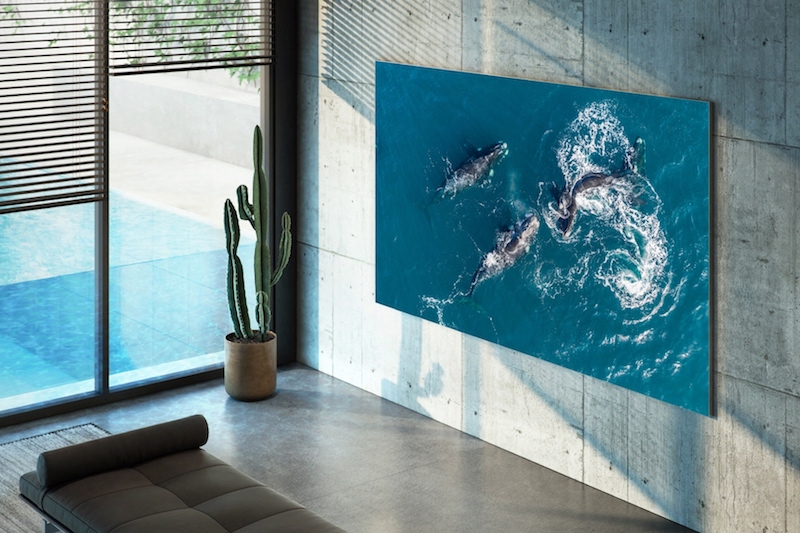Videowalls are having a moment. The Sphere has transformed the Las Vegas skyline. The videowall-as-moving stage that TAIT created for Justin Timberlake’s Forget Tomorrow World Tour has pushed the envelope for stadium performances. Large-scale immersive experiences like these have redefined the concept of “an impressive display,” bringing new expectations and demands to elite residential and resimercial markets.
Still, the vast majority of videowall equipment is produced for the commercial market. There are a host of design considerations and gotchas related to bringing this traditionally commercial application into a residential context. In this article, my aim is to identify when residential videowall deployment makes sense, demystify the design considerations, and offer some practical advice for residential integrators looking to take on videowall projects.
The Videowall Mistique
As a large-format display technology, videowalls have several clear advantages over projection. They run cooler and therefore quieter, since they don’t require a powerful fan to prevent overheating. They offer incredible contrast, with true blacks and vivid color saturation, as well as a far wider off-axis viewing area. Direct view displays are also less impacted by ambient light, making videowalls an appealing choice for outdoor applications and open-plan media rooms.
Because videowalls are generally driven by computers, they are easy to integrate with a wide variety of digital and internet-based sources, including streaming video, gaming, and conferencing applications. Finally, since LED displays in particular are infinitely configurable, you can use them for a wide variety of creative applications, including cinemascope displays and art installations.
Let’s be honest, though; customers aren’t paying mid-six figures for blacker blacks. The popularity of videowalls, particularly fine-pitch and microLED applications, stems from an undeniable “wow” factor that overwhelms the senses and transports the viewer to a new world. This immersive power is why clients are willing to pay the big bucks, and a videowall design must both deliver the desired impact and protect the client’s investment.
LED Pixel Pitch
When deploying an LED videowall application, one of the most important considerations for both cost and experience is pixel pitch. Pixel pitch is the distance between the center of two adjacent pictures on an LED tile, measured in millimeters. The smaller your pixel pitch, the more densely packed the board is with LEDs.
Fine-pitch LED displays typically have a pixel pitch of 1.2-1.5mm, with some gaming monitors and high-end displays getting down to 0.9mm. MicroLEDs have a pixel pitch of less than 0.9mm, and average around 0.5mm — three times as many pixels per square inch as a standard LED display.

Generally, the finer the pixel pitch, the higher the cost. Many people will advise a custom integrator to go with the finest pixel pitch their client will pay for, but finer isn’t always better. More pixels mean increased brightness, which is good for applications with a lot of ambient light but requires increased power and potentially causes eye strain.
An increased pixel count also requires more processing, which raises costs and power consumption even more and makes the equipment more sensitive to overheating and electrical interference. Plus, there are diminishing returns on pixel pitch as viewer distance increases; when viewers get too far away, fine details become difficult to distinguish. There’s no point in paying for pixels that don’t improve the user experience.
Viewer Distance
Integrators are accustomed to using viewer distance to determine appropriate display size and vice versa, but when you factor in pixel pitch, things get complicated. All the old rules apply: the screen shouldn’t be so wide that the closest viewer has to swivel their head back and forth to take in the whole image but must be tall enough that the farthest viewer can discern every detail. However, with a videowall, part of the goal is immersion. You’re looking for the viewer distance sweet spot where the image looks real.
When you step far enough away from a screen that you can no longer detect individual pixels and the image blends into a seamless whole, you’ve reached the Visual Acuity Distance (VAD). People with 20/20 vision can discern details as small as 1/60th of an arc degree, so if you’re aiming for immersive realism, the average viewer should be far enough away that the viewing angle between the dead centers of two adjacent pixels is less than 1/60th of a degree apart.
Thankfully, there’s a simple formula for this, and some even easier back-of-the-napkin math that will get you close enough. The formula for VAD is: VAD = Pixel Pitch X 3438.
So, if you’re deploying a microLED videowall with a 1.00mm pixel pitch, the average viewer should be no more than 1.00 X 3438 millimeters away (3.4m / 11.25 ft.) Any closer than that, and the individual pixels start to be discernable, degrading the user experience — meaning you might need an even finer pitch.
If you’re working in U.S. customary units, you can use a kind of cheat code known as the 10X rule: Pixel Pitch in millimeters X 10 = Approximate VAD in feet.
Using the 10X rule, a display with a 1.0mm pixel pitch should have an average viewer distance of 10 ft. Close enough!
That approximation is okay because really, this is all pretty subjective. Actual comfortable viewing distance will be based on the viewing task, level of focus, and individual user eyesight. Samsung recommends eight feet for every 1 mm of pixel pitch, which means the average viewer for a 1.0mm pixel pitch display can scoot forward to eight feet. The Average Comfortable Viewing Distance chart, a commonly used chart in the commercial AV industry based on subjective feedback from real-world installations, generally pegs acceptable viewing distance at about half of VAD — in this case, five feet. Basically, it’s okay if your closest viewer can pick out a pixel or two by squinting. Don’t let the quest for perfection drive costs into the stratosphere.
Residential Expectations, Commercial Supply
The bulk of LED videowall panels are built with the commercial market in mind. That means they often lack features that residential clients expect or have characteristics that surprise homeowners. You’ll need to design to compensate and set expectations accordingly.
For instance, 4K HDR isn’t the automatic standard for commercial videowall boards. These displays are deployed at such large scale and viewed from such long distances that 1080p resolution or lower is not only totally sufficient to the user experience but allows much needed processing headroom. It’s therefore essential, when sourcing components, to ensure you’re matching the resolutions and refresh rates for residential content. Also, despite the massive canvas, videowall displays don’t necessarily come with built-in multiview capabilities. If your client is looking for PIP, quad view, or other multi-view applications, you’ll need to add a third-party videowall controller to the mix.
Because they’re intended for deployment in brightly lit spaces like lobbies or outdoor areas, LED videowalls can be blindingly bright, particularly those densely packed fine-pitch and microLED displays. You’ll need to adjust the display brightness and, in outdoor applications, consider integrating an ambient light sensor to automatically adjust brightness and avoid frying your clients’ retinas at night.
Finally, many residential clients are surprised to learn that most LED videowalls don’t really turn off. Instead, the remain in a low-power mode, avoiding a full on/off cycle that can stress the delicate electronics. In outdoor applications, the videowall may also have a continuously operating cooling system. Pro tip: homeowners who are big on biophilic lighting may need to consider ways to retract or conceal the videowall when not in use.
Bridging Two Worlds
LED videowalls are admittedly complicated, and still very expensive. Projection remains the most attractive solution in a lot of scenarios, such as home theater. It’s familiar, proven, and relatively cost-effective. For users looking to create wow moments in brightly lit areas, however, videowalls are an exciting new frontier. With the proper planning and know-how, you can adapt commercial solutions to this new context.
Of course, it helps to have vendor partners who operate in both markets, understanding both residential standards and requirements and commercial products and capabilities. When selecting a videowall suppliers, it is important to look beyond specs and pricing to customer service reputation and warranty practices. The LED tile market is notorious for inconsistent supply and support. A commercial project may be able to absorb 10% dead boards per shipment as overhead, but that won’t fly in the residential world.
Everything about videowalls is big: the images, the costs, the risks, and the opportunity. With the right partners, you can harness this technology to create truly breathtaking experiences.








